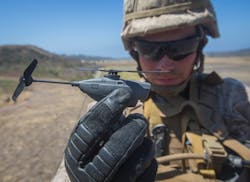Tiny UAV Keeps Tabs on GPS-Denied Regions
One trend in unmanned aerial vehicles (UAVs) for military use is an increase in capabilities in smaller aircraft. Perhaps the best embodiment of that trend is the Black Hornet 3 nano-UAV recently launched by FLIR Systems. The Black Hornet Personal Reconnaissance System (PRS) had been the world’s smallest combat-proven nano-UAV. The same company’s Black Hornet nano-UAV (see figure) has the capability to navigate in GPS-denied environments for effective operation even in the most challenging battle places, including indoors for surveillance missions.
The Black Hornet 3 weighs just 32 g and has been fielded by more than 30 nations. It can cover a distance of 2 km while flying at speeds exceeding 21 km/hr. Its small size and agility makes it a likely candidate for applications in intelligence, surveillance, and target acquisition. It operates with a FLIR Lepton thermal microcamera and visible sensor for high-quality imaging capability. The enhanced design of the miniature UAV incorporates an improved encrypted digital datalink for secure and reliable communications in tight spaces and in beyond-line-of-sight applications.
This tiny UAV can perform surveillance even in areas that are outside of the range of GPS satellites.
“We are excited to bring this advanced Black Hornet 3 to our warfighters and first responders,” said James Cannon, president and CEO of FLIR. “With longer range and indoor flight capabilities, the latest generation Black Hornet provides full surveillance coverage continuity to the mission. The Black Hornet 3 is representative of FLIR’s new focus on providing full-solution technology, and we look forward to playing a role in helping modernize our military customers.”
The Black Hornet includes two UAV sensors, a controller, and a display. The interest from the military is apparent, as FLIR recently announced a $2.6 million order from the U.S. Army’s Soldier Borne Sensor (SBS) program for a first-batch order of the compact, advanced UAV. This is in addition to units recently deployed by the Royal Australian Army and French Armed Forces.
About the Author
Jack Browne
Technical Contributor
Jack Browne, Technical Contributor, has worked in technical publishing for over 30 years. He managed the content and production of three technical journals while at the American Institute of Physics, including Medical Physics and the Journal of Vacuum Science & Technology. He has been a Publisher and Editor for Penton Media, started the firm’s Wireless Symposium & Exhibition trade show in 1993, and currently serves as Technical Contributor for that company's Microwaves & RF magazine. Browne, who holds a BS in Mathematics from City College of New York and BA degrees in English and Philosophy from Fordham University, is a member of the IEEE.


